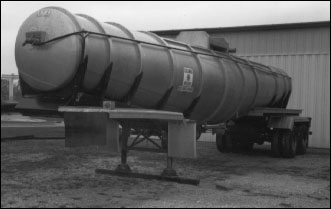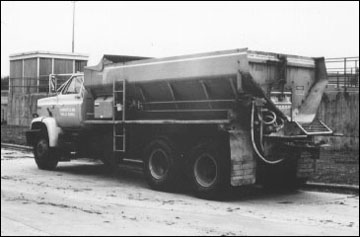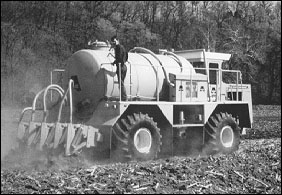Biosolids are a product of the municipal wastewater treatment process. Typically, biosolids contain minerals and organic matter that can be beneficial to the soil and crop environment, and to the general tilth of the soil. See MU publications WQ428 and WQ430 for detailed information on nutrient content and agronomic considerations for applying biosolids to crops. This publication discusses equipment commonly used when biosolids are applied off-site on land some distance away from the treatment plant.
Biosolids characteristics
The physical characteristics of biosolids influence the type of handling equipment needed. Liquid biosolids resulting from the treatment of municipal sewage have a dry matter content of 3 percent to 6 percent. This type of biosolids is a somewhat viscous fluid (similar to a chocolate malt) and so can be handled hydraulically by pumps, pipelines and applicators designed for this type of material.
Biosolids that are further dewatered by filter or press (also referred to as cake biosolids) may contain up to 40 percent dry matter. This type of biosolids is handled by mechanical loading, hauling and spreading equipment. The obvious advantage of the drier biosolids is the significant reduction in water volume, which, in turn, reduces handling costs.
Land application of biosolids
Land application of biosolids usually is accomplished using one of two procedures, commonly referred to as the off-site and on-site methods.
Off-site management of biosolids involves loading, hauling and land-applying biosolids at a location some distance from the treatment plant. Limitations with this technique include high labor requirements, feasible hauling distance, the need for more transfer tankers as hauling distances increase, and the relatively low daily rate at which biosolids can be land-applied. The primary advantage of this procedure is the ability to make use of remote tracts of land that may be scattered some distance from the treatment plant. This system is used commonly for application to privately owned farm land.
Equipment for off-site land application of solids
Liquid biosolids are usually accumulated in some type of short- or long-term storage facility that may serve as a loading station for off-site application of biosolids. Figure 1 is an example of this type of loading station. In some cases it may be advantageous to locate this loading station some distance from the treatment plant. Then the biosolids are pumped to the loading station, reducing the distance they must be hauled over the road.
 Figure 1
Figure 1
Tanker loading station for hauling biosolids off-site.
Biosolids may be hauled from the treatment plant to the land-application site by the land-application equipment itself or by tankers that transfer the biosolids to the applicator on-site. Since over-the-road hauling is a relatively inefficient use of land-application equipment, most large systems are set up with one or more tankers to serve the applicator at the land-application site. Figure 2 is an example of a typical tanker used to supply biosolids to a land applicator. Figure 3 shows the transfer of biosolids at the land-application site.
 Figure 2
Figure 2
This 6,000-gallon tanker is used to haul biosolids from the treatment plant.
 Figure 3
Figure 3
Biosolids are transferred from the tanker to the field applicator.
Any tank-type vehicle may be used for hauling biosolids, but semi-trailer type tankers holding 6,000 gallons to 7,000 gallons are most common. The number of tankers required depends primarily on the hauling distance. Usually, it is desirable to keep the land applicator running as continuously as possible, which makes more tankers necessary as hauling distances increase. Hauling distances of 5 miles to 15 miles are typical.
Off-site land application can be accomplished with applicators designed to handle the material being applied. Cake biosolids or dewatered biosolids in the range of 25 percent to 35 percent dry matter can be land-applied with mechanical equipment such as flail or beater-type spreaders. Common farm-type manure spreaders pulled by a tractor may be used, or spreaders can be mounted on a truck chassis (Figure 4) to increase hauling efficiency. Biosolids that are surface-spread in this manner may be incorporated into the soil with a tillage operation soon after spreading. This will reduce potential vector transmission via aerosol or runoff resulting from rainfall events.
 Figure 4
Figure 4
Dry biosolids are applied with mechanical spreading equipment.
Off-site land application of fluid biosolids in the 3 percent to 6 percent dry matter range can be accomplished with a tank-type vehicle equipped to discharge and spread the contained fluid at the proper rate. This type of applicator may be equipped with chisels or knives that provide subsurface injection of the biosolids. Subsurface application has the advantage of conserving nutrients and minimizing the contamination potential from stormwater-induced runoff. Conventional farm-type manure tank wagons, with or without injectors, may be used for biosolids as shown in Figure 5.
Much land in the southern and Ozark regions of Missouri is not suitable for injection because of shallow, rocky soils, making it necessary to surface-spread biosolids, as shown in Figure 6. Tank wagons holding 1,000 gallons to 5,000 gallons can be equipped with the appropriate injectors. Tractor power requirements for large tank wagons with injectors are significant. Farm-type equipment is most applicable to smaller systems and may serve other functions, such as manure hauling, when not being used for biosolids.
 Figure 5
Figure 5
Biosolids can be applied with injectors on a manure tank wagon.
 Figure 6
Figure 6
Biosolids being surface spread from a manure tank wagon.
Tanks mounted on powered chassis that are equipped with large, low-pressure tires for traversing soft ground are used most commonly for land-applying biosolids (Figure 7). Knife or chisel tool bars for subsurface injection are mounted on the rear of such applicators, as shown in Figure 8. Although these units are capable of injecting into pasture or sod, the resulting rough surface may be unacceptable for subsequent land use such as grazing or haying. Therefore, injection is more appropriate on land cultivated for row crops or small grains. These applicators are typically in the 3,000-gallon to 5,000-gallon range and are capable of injecting this volume in 4 minutes to 8 minutes. Surface application equipment (without injection) may be used on grassland or other land that meets site restrictions and best management practices for minimizing stormwater runoff.
 Figure 7
Figure 7
Applicator injecting biosolids into crop land.
 Figure 8
Figure 8
Injectors on applicators provide subsurface application of biosolids.
References
- City of Columbia, Columbia Wastewater Treatment Plant, Sludge Management Program.
- Missouri Department of Natural Resources, Division of Environmental Quality. Agricultural Use of Municipal Wastewater Sludge — a planning guide. January 1985.
- USEPA. Biosolids Technology Fact Sheet: Land Application of Biosolids EPA 832-F-00-064, September 2000.
- Lu, Q., He, Z. L., and Stoffell, P. J. Land Application of Biosolids in the USA: A Review. Applied and Environmental Soil Science, Volume 2012, Article ID 201462, doi:10.1155/2012/201462